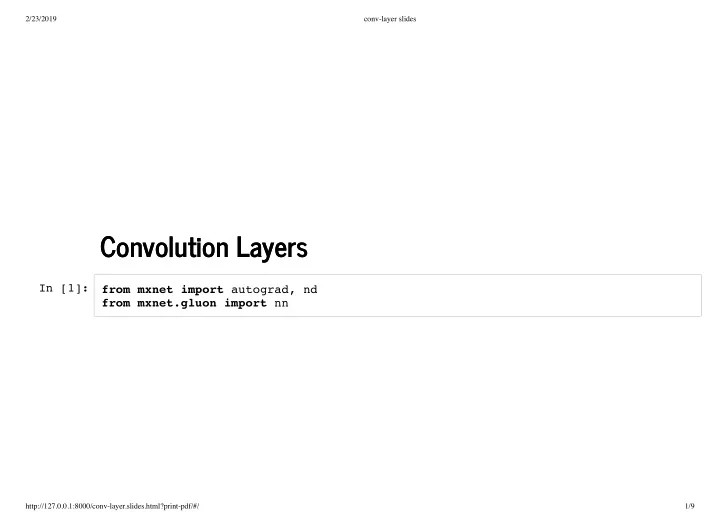

2/23/2019 conv-layer slides Convolution Layers Convolution Layers In [1]: from mxnet import autograd, nd from mxnet.gluon import nn http://127.0.0.1:8000/conv-layer.slides.html?print-pdf/#/ 1/9
2/23/2019 conv-layer slides The Cross Correlation Operator The Cross Correlation Operator In [2]: def corr2d(X, K): h, w = K.shape Y = nd.zeros((X.shape[0] - h + 1, X.shape[1] - w + 1)) for i in range(Y.shape[0]): for j in range(Y.shape[1]): Y[i, j] = (X[i: i + h, j: j + w] * K).sum() return Y http://127.0.0.1:8000/conv-layer.slides.html?print-pdf/#/ 2/9
2/23/2019 conv-layer slides Sanity Test Sanity Test In [3]: X = nd.array([[0, 1, 2], [3, 4, 5], [6, 7, 8]]) K = nd.array([[0, 1], [2, 3]]) corr2d(X, K) [[19. 25.] Out[3]: [37. 43.]] <NDArray 2x2 @cpu(0)> http://127.0.0.1:8000/conv-layer.slides.html?print-pdf/#/ 3/9
2/23/2019 conv-layer slides Convolutional Layers Convolutional Layers In [4]: class Conv2D (nn.Block): def __init__(self, kernel_size, **kwargs): super(Conv2D, self).__init__(**kwargs) self.weight = self.params.get('weight', shape=kernel_size) self.bias = self.params.get('bias', shape=(1,)) def forward(self, x): return corr2d(x, self.weight.data()) + self.bias.data() http://127.0.0.1:8000/conv-layer.slides.html?print-pdf/#/ 4/9
2/23/2019 conv-layer slides Object Edge Detection in Images Object Edge Detection in Images In [5]: X = nd.ones((6, 8)) X[:, 2:6] = 0 X [[1. 1. 0. 0. 0. 0. 1. 1.] Out[5]: [1. 1. 0. 0. 0. 0. 1. 1.] [1. 1. 0. 0. 0. 0. 1. 1.] [1. 1. 0. 0. 0. 0. 1. 1.] [1. 1. 0. 0. 0. 0. 1. 1.] [1. 1. 0. 0. 0. 0. 1. 1.]] <NDArray 6x8 @cpu(0)> http://127.0.0.1:8000/conv-layer.slides.html?print-pdf/#/ 5/9
2/23/2019 conv-layer slides Detect Vertical Edges Detect Vertical Edges In [6]: K = nd.array([[1, -1]]) Y = corr2d(X, K) print(X, Y) [[1. 1. 0. 0. 0. 0. 1. 1.] [1. 1. 0. 0. 0. 0. 1. 1.] [1. 1. 0. 0. 0. 0. 1. 1.] [1. 1. 0. 0. 0. 0. 1. 1.] [1. 1. 0. 0. 0. 0. 1. 1.] [1. 1. 0. 0. 0. 0. 1. 1.]] <NDArray 6x8 @cpu(0)> [[ 0. 1. 0. 0. 0. -1. 0.] [ 0. 1. 0. 0. 0. -1. 0.] [ 0. 1. 0. 0. 0. -1. 0.] [ 0. 1. 0. 0. 0. -1. 0.] [ 0. 1. 0. 0. 0. -1. 0.] [ 0. 1. 0. 0. 0. -1. 0.]] <NDArray 6x7 @cpu(0)> http://127.0.0.1:8000/conv-layer.slides.html?print-pdf/#/ 6/9
2/23/2019 conv-layer slides Can't Detect Horizon Edges Can't Detect Horizon Edges In [7]: Z = corr2d(X.T, K) print(X.T,Z) [[1. 1. 1. 1. 1. 1.] [1. 1. 1. 1. 1. 1.] [0. 0. 0. 0. 0. 0.] [0. 0. 0. 0. 0. 0.] [0. 0. 0. 0. 0. 0.] [0. 0. 0. 0. 0. 0.] [1. 1. 1. 1. 1. 1.] [1. 1. 1. 1. 1. 1.]] <NDArray 8x6 @cpu(0)> [[0. 0. 0. 0. 0.] [0. 0. 0. 0. 0.] [0. 0. 0. 0. 0.] [0. 0. 0. 0. 0.] [0. 0. 0. 0. 0.] [0. 0. 0. 0. 0.] [0. 0. 0. 0. 0.] [0. 0. 0. 0. 0.]] <NDArray 8x5 @cpu(0)> http://127.0.0.1:8000/conv-layer.slides.html?print-pdf/#/ 7/9
2/23/2019 conv-layer slides Learning a Kernel Learning a Kernel In [8]: conv2d = nn.Conv2D(1, kernel_size=(1, 2)) conv2d.initialize() X = X.reshape((1, 1, 6, 8)) Y = Y.reshape((1, 1, 6, 7)) for i in range(10): with autograd.record(): Y_hat = conv2d(X) l = (Y_hat - Y) ** 2 l.backward() conv2d.weight.data()[:] -= 3e-2 * conv2d.weight.grad() if (i + 1) % 2 == 0: print('batch %d , loss %.3f ' % (i + 1, l.sum().asscalar())) batch 2, loss 4.949 batch 4, loss 0.831 batch 6, loss 0.140 batch 8, loss 0.024 batch 10, loss 0.004 http://127.0.0.1:8000/conv-layer.slides.html?print-pdf/#/ 8/9
2/23/2019 conv-layer slides Learned Kernel Learned Kernel In [9]: conv2d.weight.data().reshape((1, 2)) [[ 0.9895 -0.9873705]] Out[9]: <NDArray 1x2 @cpu(0)> http://127.0.0.1:8000/conv-layer.slides.html?print-pdf/#/ 9/9
Recommend
More recommend